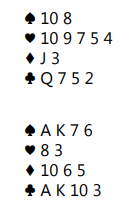

Source: www.abfevents.com.au newsletter February 2019
BOOK REVIEWED: HAND OF THE WEEK by Joel Martineau
 Liam Milne (right) with Andy Hung
Liam Milne (right) with Andy Hung
Playing against sound opponents, with only their side vulnerable at matchpoints, you have this dicey auction to find yourself declaring 2![]() :
:

A rather weak dummy comes down with a few trumps:
 After West leads the
After West leads the![]() 2, how would you plan the play of the
2, how would you plan the play of the
hand in 2![]() ?
?
Joel Martineau’s ‘Hand of the Week’ loosely covers the author’s most instructive hand of each week during a year of his bridge play, often with his bridge students. Martineau writes in a style that turns each hand into a story (similar to the Terence Reese’s classic ‘Play These Hands with Me’) rather than presenting each hand as a dry problem. Nevertheless, industrious readers will not find it hard to stop at the key point and take a moment to work out what the best play is, so the book also works well as a quiz book.
The focus is firmly on card play, both as declarer and defender. The bidding receives brief attention, but the commentary on the auction is always sensible. I found the auctions to be solid and always comprehensible; any deviations from ‘standard’ were usually justified.
What I enjoyed most about ‘Hand of the Week’ was the author’s constant reinforcing of the ‘bread and butter’ skills that come easily to experts but are patchier amongst improving players. There is an emphasis on using all the available information to come up with the best play. Following his thought processes as he navigates each of the 52 deals is instructive, especially because of Martineau’s career as a bridge coach.
The level of the problems will suit the majority of the readers: they are difficult enough that they do not solve themselves, yet there are always enough clues to find the winning play. Frequently, each story leads to a discussion about a wider theme in card play that can be applied to other hands. Although experts might find some of the hands too easy, I enjoyed reading Martineau’s take on most of the 52 hands.
Usually, the highlighted play is more about ‘practical’ aspects of play (often card-reading) as opposed to pure technical knowledge. In the example problem above, the author shrewdly works out that for his opponents not to have competed further with their combined 23 HCP, diamonds must be 5-3 and the points are likely to be split 13-10 (otherwise each opponent might have bid again). With a reasonable hand, East’s most likely reason for not competing over 2![]() was that he was a 4-3-3-3 shape.
was that he was a 4-3-3-3 shape.
With the objective of worrying the opponents about a potential cross-ruff, the right play is to win the lead and advance the ![]() 8. When East wins the
8. When East wins the ![]() Q and switches to clubs, declarer wins in hand to lead another heart. After West wins the second heart and continues with a trump, dummy wins the
Q and switches to clubs, declarer wins in hand to lead another heart. After West wins the second heart and continues with a trump, dummy wins the ![]() Q and leads a third heart, ruffed low. As expected, the hearts break 3-3 and declarer draws the last trump, claiming +110 and a great matchpoint score.
Q and leads a third heart, ruffed low. As expected, the hearts break 3-3 and declarer draws the last trump, claiming +110 and a great matchpoint score.
Finally, a bit of colour is provided by the author’s sensible noncardplay advice. Here’s one quote that we should all follow: “No matter how unlikely your line, embark as though you have a solid plan and look for ways to increase your chances. A reminder: When partner tables dummy never, ever say anything except ‘Thank you, partner’.”






